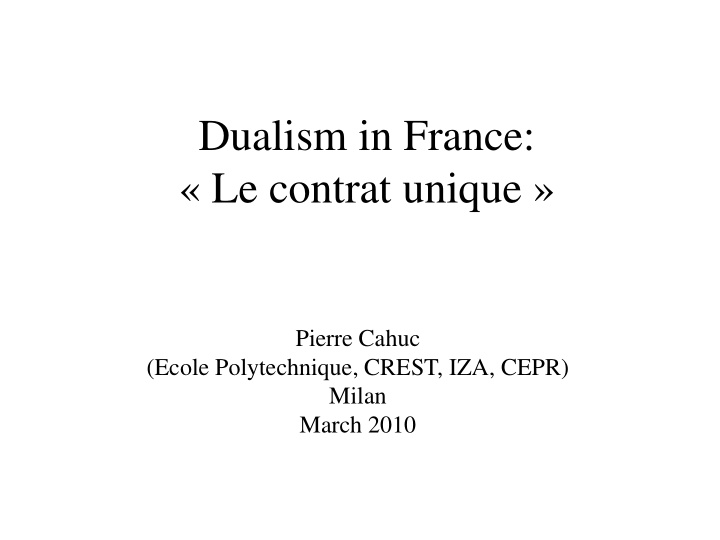



Dualism in France: « Le contrat unique » Pierre Cahuc (Ecole Polytechnique, CREST, IZA, CEPR) Milan March 2010
• Presentation relies on reports • Pierre Cahuc and Francis Kramarz (2004) • Olivier Blanchard and Jean Tirole (2004) • Pierre Cahuc and Francis Kramarz: Deep coordinated reform of 1. employment services 2. product market regulation 3. labor contract (contrat unique) • Olivier Blanchard and Jean Tirole (2004): Deep reform of the labor contract (contrat unique)
Dualism in France • 30 000 job separations every day in France • Adjustment relies to a large extent on the youth because • many short term contracts • stringent protection of permanent contracts
Many fixed term jobs for young workers
Median unemployment duration by age
Do you worry about the possibilities of losing your job? I worry a great deal I worry to some extent I worry a little I don’t worry at all” Feeling of job security OECD EPL indicator EPL is negatively correlated with the feeling of job security
Propose deep change in the regulation of the employment relation Basic idea: protect individuals instead of protect jobs (flexicurity) • employment services (to move between jobs) • product market regulation in service industry (to favor job creation, especially for young people) • labor contract
Single labor contract Strong EPL in France Firing for economic causes • Complex procedures • Important intervention of the State (Ministery of labor) • Employers have to try to keep the workers in the firm (provide training…) • Long delay • Weak role of trade unions (only on the procedure) Strong judicial insecurity • Problem with the definition of economic causes: can « safeguard » the competitivity of the firm, but cannot fire to « improve » the competitivity of the firm.
A lle m a g n e 2 2 , 6 1 , 1 A u s t ra lie E t a t s -U n is 0 , 0 3 F in la n d e 5 , 1 F ra n c e 2 5 , 1 Irla n d e 3 , 5 It a lie 1 , 6 N o u ve lle -Z é la n d e 7 , 8 R o y a u m e -U n i 7 , 1 0 5 1 0 1 5 2 0 2 5 3 0 Percentage of layoffs giving rise to legal proceedings in the end of the 1990’s. Source : OECD
The Law is circumvented • Layoffs for economic causes = 2 percent of separations (has been divided by 3 since the beginning of the 1990s) Collective layoffs = 0.5 percent of job separations • • 70% of recruitings are fixed term jobs (should be the exception according to the law: replacement, seasonal work, temporary increase in compagny activity)
Proposal : single contract 1. Same regime whatever the term (fixed or indeterminate) of the contract - Dismissals prohibited if based on discrimination, pregnancy, exercise of a legal right (trade union membership…). Otherwise authorized - Notice period increases with seniority (zero at the beginning…) - Simple procedure (letter, interview, if indeterminate duration) - No imposed order of dismissals for collective dismissals
2. Counterpart: Layoff tax - difference in the social value and the private value of the job - experience rating (in the US), tax used to finance public employment services - Amount of the tax: 1.6 percent of the wages paid to the fired workers + 10 percent for the 18 first months
Layoff costs (in monthly wage units) and seniority (in year)
Recommend
More recommend